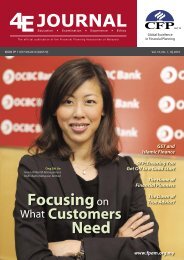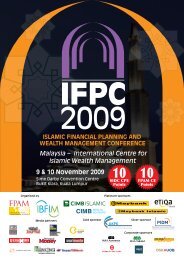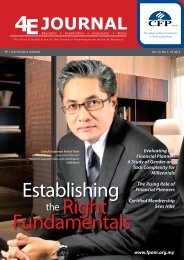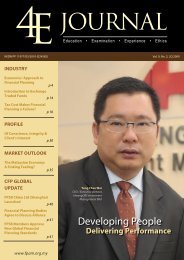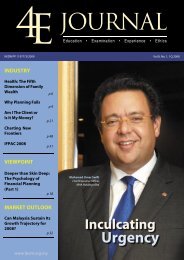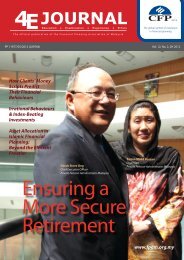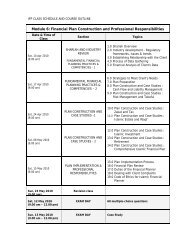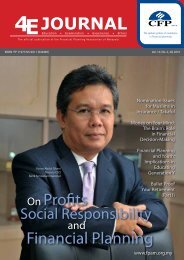Vol 10, No 3 - Financial Planning Association of Malaysia
Vol 10, No 3 - Financial Planning Association of Malaysia
Vol 10, No 3 - Financial Planning Association of Malaysia
Create successful ePaper yourself
Turn your PDF publications into a flip-book with our unique Google optimized e-Paper software.
etirement, you can ease their anxiety<br />
and cure their finertia by helping them<br />
develop an income strategy. The process,<br />
which involves charting the client’s<br />
retirement expenses and sources <strong>of</strong><br />
income, takes the mystery and complexity<br />
out <strong>of</strong> the “magic number” by breaking it<br />
down into categories to which your clients<br />
can relate. You can use charts that look<br />
just like a standard budgeting worksheet,<br />
with estimated discretionary and<br />
nondiscretionary expenses in one table<br />
and retirement savings and investments<br />
in another.<br />
but a complete reversal. Plummeting<br />
home values have damaged a great deal<br />
more than our pocketbooks — many an<br />
ego has been badly bruised.<br />
Adviser Takeaway. Understanding the<br />
complex and deep-seated emotional<br />
attachments people have to their homes<br />
is the first step in helping repair the<br />
damage for clients who made the mistake<br />
<strong>of</strong> viewing their homes as retirement<br />
accounts. Getting them to see that a<br />
house is a shelter and not an investment<br />
is the first step. If you can convince<br />
them <strong>of</strong> that, they will be more open to<br />
considering alternative options.<br />
Some <strong>of</strong> the solutions are surprisingly<br />
simple, but can have a tangible effect on<br />
a very complex problem. For example,<br />
retirees who don’t have a lot <strong>of</strong> equity<br />
in their homes might want to consider<br />
renting a smaller house in retirement.<br />
For clients who plan to stay in their<br />
homes, overpaying their mortgages by<br />
US$<strong>10</strong>0 or so a month can save them<br />
tens <strong>of</strong> thousands <strong>of</strong> dollars over the life<br />
<strong>of</strong> the loan and dramatically reduce the<br />
number <strong>of</strong> years they will be paying <strong>of</strong>f<br />
their homes. 1 This last option is a perfect<br />
example <strong>of</strong> how a small, seemingly<br />
inconsequential decision can have a<br />
significant effect on the retirement<br />
planning continuum.<br />
Number Numbness<br />
Whether it is the staggering sums<br />
reported in relation to the federal deficit<br />
and national debt, or the elusive “number”<br />
representing an adequate retirement<br />
nest egg, people are easily overwhelmed<br />
— and subsequently numbed — by the<br />
sheer size <strong>of</strong> numbers that seem too large<br />
to comprehend. Number numbness leads<br />
to what I have dubbed “finertia,” which is<br />
the paralysis that sets in when investors<br />
try to make sense <strong>of</strong> contradictory and<br />
confusing financial information. Finertia<br />
makes the prospect <strong>of</strong> planning for<br />
retirement too complex to face, which<br />
may explain why so many people have<br />
opted to simply do nothing.<br />
For most <strong>of</strong> your clients, the most<br />
numbing number <strong>of</strong> all is the amount<br />
they need to comfortably retire. Even you,<br />
as an experienced financial pr<strong>of</strong>essional,<br />
cannot say for certain what that number<br />
should be. A Monte Carlo simulation<br />
can supposedly account for hundreds <strong>of</strong><br />
thousands <strong>of</strong> potential market scenarios,<br />
but no formula is advanced enough to<br />
predict the future — there are simply<br />
too many variables. The task is further<br />
complicated by the human emotions<br />
involved — you must factor in your<br />
clients’ changing needs and desires,<br />
their expectations, and the effects <strong>of</strong><br />
unanticipated family situations or market<br />
movements. Macro issues such as inflation,<br />
longevity, healthcare, and taxes add yet<br />
another layer <strong>of</strong> complexity.<br />
Number numbness is not only relegated<br />
to vast quantities; it can also take the form<br />
<strong>of</strong> “bigness bias,” which is the tendency to<br />
be indifferent to small numbers such as 1<br />
or 2 percent. Overlooking small numbers<br />
can be a big problem when it comes to<br />
accounting for taxes and inflation in a<br />
long-term financial plan. Consider the<br />
investors who were making big returns<br />
on equity investments during the 18-year<br />
bull market <strong>of</strong> 1982–2000. At the time,<br />
inflation was barely perceptible at 1 or 2<br />
percent annually, but it was still slowly<br />
eating away at the purchasing power <strong>of</strong><br />
every dollar investors earned.<br />
Adviser Takeaway. While you may be<br />
powerless to predict the exact dollar<br />
amount your clients will need for<br />
Retirement planning is never going<br />
to get less complex; in fact, the effects<br />
<strong>of</strong> the financial meltdown we have<br />
just experienced will likely exacerbate<br />
the issue for many years to come. As<br />
an adviser, it is your job to handle the<br />
complexity based on your knowledge and<br />
experience, while making the process as<br />
simple as possible for your clients. Begin<br />
with this lesson: every large amount<br />
starts as a small amount — the key to<br />
making your money grow is time and<br />
discipline. It may seem overly simplistic,<br />
but for anyone who is intimidated by the<br />
numbers involved in accumulating the<br />
money needed for retirement, this is a<br />
compelling and comforting concept.<br />
Layering—The Proxy Perception<br />
Just as Las Vegas has learned that people<br />
will toss chips around far more liberally<br />
than cash, the credit card industry knows<br />
very well that people treat those little<br />
plastic rectangles differently than actual<br />
money. Credit cards, debit cards, and<br />
electronic bank statements are quick<br />
and convenient, but these automated<br />
forms <strong>of</strong> payment create a psychological<br />
disconnect that makes money more<br />
opaque to consumers. In behavioural<br />
finance, the concept is known as<br />
“layering” — a term borrowed from moneylaundering<br />
that refers to the layers <strong>of</strong><br />
separation from the place where the<br />
money was originally earned. The thicker<br />
the layers, the greater the opportunity for<br />
clients to make poor financial decisions.<br />
The physical proxy <strong>of</strong> the check or<br />
credit card creates one layer; we are<br />
further removed from our money by the<br />
expediency and opaqueness <strong>of</strong> the entire<br />
transaction process at most retail outlets.<br />
Signatures are seldom required when we<br />
use credit or debit cards, and quite <strong>of</strong>ten,<br />
“Finertia makes the prospect <strong>of</strong> planning for<br />
retirement too complex to face, which may explain<br />
why so many people have opted to simply do nothing.”<br />
The 4E Journal 25



